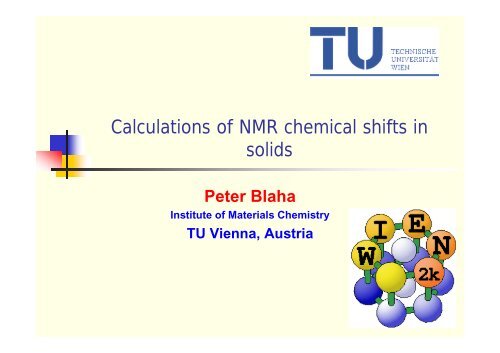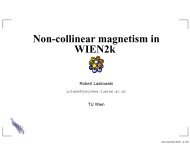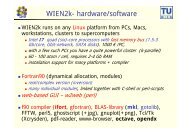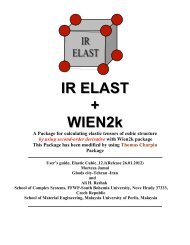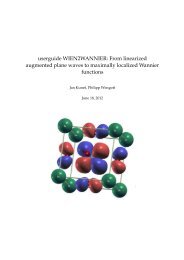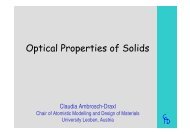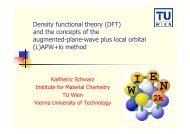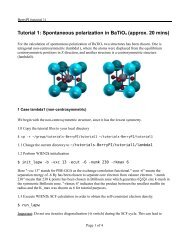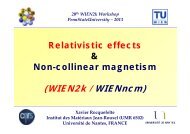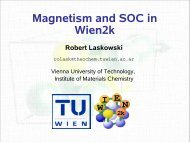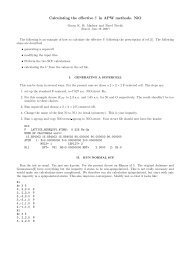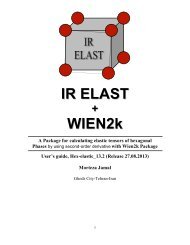Calculation and interpretations of NMR Chemical shifts - WIEN 2k
Calculation and interpretations of NMR Chemical shifts - WIEN 2k
Calculation and interpretations of NMR Chemical shifts - WIEN 2k
- No tags were found...
You also want an ePaper? Increase the reach of your titles
YUMPU automatically turns print PDFs into web optimized ePapers that Google loves.
<strong>NMR</strong> spectroscopy
<strong>NMR</strong> HamiltonianperturbationZeeman Hamiltonianelectric quadrupoleinteraction (EFG)direct dipolarcouplingIndirect spinspincouplingmagnetic shielding
<strong>NMR</strong> HamiltonianZeeman HamiltonianH Q eQ/ hquadrupole interactionmagnetic shielding
<strong>NMR</strong> shielding, chemical shift:(R)is the shielding tensor at the nucleus Rchemical shift:
Biot - Savart lawThe induced magnetic field (B ind ) is derived from theinduced current (j ind ) using a st<strong>and</strong>ard formula:in DFT the current density j(r) will be:diamagn.paramagn.perturbed w.f. 1is obtained from perturbation theorysum over all empty states magnetic field
• run normal scf cyclepractical calculation• x_nmr_lapw -mode in1 [-focus O ]• view the resulting *in1c_nmr file• x_nmr_lapw [-p]• creates several directories (“nmr_q0, nmr_pqx, nmr_mqx, nmr_pqy, ..)<strong>and</strong> performs lapw1/2 steps for several k-meshes (k ± q)• creates the current• integrates the current• tail case.outputnmr_integWFFIL EF=.533144859350 (WFFIL, WFPRI, ENFIL,7.00 10 4 (R-MT*K-MAX; MAX L IN WF, V-NMT0.30 19 0 (GLOBAL E-PARAMETER WITH n OTH0 -0.58576 0.002 CONT 10 4.80000 0.000 CONT 10 36.60000 0.000 CONT 10 66.66000 0.000 CONT 10 104.26000 0.000 CONT 10 149.26000 0.000 CONT 10 201.50000 0.000 CONT 1…• :<strong>NMR</strong>TOT003 ATOM: O 3 <strong>NMR</strong> (total/ppm) TRACE = -366.9034 ANISO = -264.8134 ASYM = -0.9504• for analysis one can calculate the shift from certain b<strong>and</strong>s(energy range) only• x_nm_lapw [-p] -noinit -emin xx [-emax yy]
Test <strong>of</strong> accuracy: Ar atom• the current j <strong>and</strong> chemical shielding <strong>of</strong> a spherical atomcan be calculated “exactly” from the density (r) (noperturbation theory) by:
Induced current in LAPWInduced current field for BaO (fcc) , B ext in (001)
<strong>NMR</strong> <strong>shifts</strong> for F, O, Br, ClFOBrCl
Interpretation <strong>of</strong> 19 F <strong>NMR</strong> shieldingin alkali fluorides• b<strong>and</strong> wise analysis• character analysis (s,p,d) <strong>of</strong> the wave function <strong>of</strong> occupied<strong>and</strong> unoccupied states
DOS <strong>of</strong> alkali fluorides (CsF)metal-p F-p b<strong>and</strong> varies between 5 eV for CsF to 20 eV for NaF
B<strong>and</strong> wise analysis <strong>of</strong> the isotropic shielding in MFF
Decomposition <strong>of</strong> <strong>NMR</strong> shift• decomposition <strong>of</strong> <strong>NMR</strong> shift according to s, p, d - character<strong>and</strong> atom• 0 = at lm R at,lm Y lm• decomposition according to ground state o(0)<strong>and</strong> perturbed states o(1)• o(1)
metal-p b<strong>and</strong> contribution o (0) |F, l=1 o (1) |F, l=1
F-p b<strong>and</strong> contribution o (1) |F, l=2 o (1) |F, l=1 o (0) |F, l=1
metal p b<strong>and</strong> F-p b<strong>and</strong> o (1) |F, l=2 o (0) |F, l=1 o (1) |F, l=1 o (1) |F, l=1 o (0) |F, l=1the only important groundstate contributionpositive, increasingcontribution within the series o (0) |F, l=1 o (1) |F, l=1 o (1) |F, l=2the only important groundstate contributionnegative, decreasingcontribution within the seriesconstant contributionwithin the series
onding / antibonding F-p / Me-p interactionRe[] at X-point <strong>of</strong> CsFa) F-p b<strong>and</strong>, anti-bonding character <strong>of</strong> the Cs-p <strong>and</strong> F-p orbitals,negative contribution to the shieldingb) Cs-p b<strong>and</strong>, bonding character between Cs-p <strong>and</strong> F-p orbitals,positive contribution to the shielding.
metal-p b<strong>and</strong> contribution
Interactions relevant for <strong>NMR</strong>chemical <strong>shifts</strong> in alkali fluoridesE dE p
A, B interactions:coupling to the metal-d states, due to F-p – metal-p hybridizationd-b<strong>and</strong> position
Effect <strong>of</strong> bond distance on the shielding• decreasing volume leads to stronger Me-p F-p interaction <strong>and</strong>to more negative shielding (Li does not have “Li-p b<strong>and</strong>”)
Effect <strong>of</strong> position <strong>of</strong> metal-d b<strong>and</strong> on the F shielding• LDA+U acting on Cs-dCsF(NaF)
The “slope” - problemexp. vs. theoretical :The slope must be ONEPBE: slope is too bigPBE+U (metal d-states):with one U value it is notpossible to fix oxygen ANDfluorine CS.
the slope - problem• hybrid-DFT is the st<strong>and</strong>ardmethod in CS calculations <strong>of</strong>molecules (Gaussian)• for (ionic) solids YS-PBE0 (HSE)gives a much too largecorrection (smaller mixing ??)
the slope - problemBJ-potential (OEP) seems quite reasonable for ionic compounds
Summary:<strong>NMR</strong> chemical <strong>shifts</strong>:• shielding <strong>of</strong> anions in solids determined by:• strength <strong>of</strong> metal-p -- F-p hybridization• distance <strong>of</strong> metal-p b<strong>and</strong> from anion-p b<strong>and</strong>• bond distance, number <strong>of</strong> neighbors• position <strong>of</strong> empty metal-d states
AcknowledgementRobert Laskowski (TU Vienna)<strong>NMR</strong>: PRB 85, 035132 (2012)PRB 85, 245117 (2012)Thank you for your attention !


